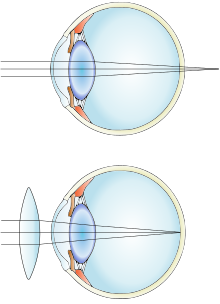
Back Hipermetropía AN مد البصر Arabic Hipermetropía AST Suai BEW Далекогледство Bulgarian দূরদৃষ্টি Bengali/Bangla Refrakcijska dalekovidnost BS Hipermetropia Catalan دووربینی CKB Dalekozrakost Czech
| Far-sightedness | |
|---|---|
| Other names | Hypermetropia, hyperopia, longsightedness, long-sightedness[1] |
 | |
| Far-sightedness without (top) and with lens correction (bottom) | |
| Specialty | Ophthalmology, optometry |
| Symptoms | Near blur, Distance and near blur, Asthenopia[2] |
| Complications | Accommodative dysfunction, binocular dysfunction, amblyopia, strabismus[3] |
| Causes | Axial length of eyeball is too short, lens or cornea is flatter than normal, aphakia[2] |
| Risk factors | Ageing, hereditary[2] |
| Diagnostic method | Eye exam |
| Differential diagnosis | Amblyopia, retrobulbar optic neuropathy, retinitis pigmentosa sine pigmento[4] |
| Treatment | Eyeglasses, contact lenses, refractive surgeries, IOL implantation[2] |
| Frequency | ~7.5% (US)[5] |
Far-sightedness, also known as long-sightedness, hypermetropia, and hyperopia, is a condition of the eye where distant objects are seen clearly but near objects appear blurred. This blur is due to incoming light being focused behind, instead of on, the retina due to insufficient accommodation by the lens.[6] Minor hypermetropia in young patients is usually corrected by their accommodation, without any defects in vision.[2] But, due to this accommodative effort for distant vision, people may complain of eye strain during prolonged reading.[2][7] If the hypermetropia is high, there will be defective vision for both distance and near.[2] People may also experience accommodative dysfunction, binocular dysfunction, amblyopia, and strabismus.[3] Newborns are almost invariably hypermetropic, but it gradually decreases as the newborn gets older.[6]
There are many causes for this condition. It may occur when the axial length of eyeball is too short or if the lens or cornea is flatter than normal.[2] Changes in refractive index of lens, alterations in position of the lens or absence of lens are the other main causes.[2] Risk factors include a family history of the condition, diabetes, certain medications, and tumors around the eye.[5][4] It is a type of refractive error.[5] Diagnosis is based on an eye exam.[5][8]
Management can occur with eyeglasses, contact lenses, or refractive corneal surgeries.[2] Glasses are easiest while contact lenses can provide a wider field of vision.[2] Surgery works by changing the shape of the cornea.[5] Far-sightedness primarily affects young children, with rates of 8% at 6 years old and 1% at 15 years old.[9] It then becomes more common again after the age of 40, known as presbyopia, affecting about half of people.[4] The best treatment option to correct hypermetropia due to aphakia is IOL implantation.[2]
Other common types of refractive errors are near-sightedness, astigmatism, and presbyopia.[10]
- ^ Cite error: The named reference
patwas invoked but never defined (see the help page). - ^ a b c d e f g h i j k l Khurana, AK (September 2008). "Errors of refraction and binocular optical defects". Theory and practice of optics and refraction (2nd ed.). Elsevier. pp. 62–66. ISBN 978-81-312-1132-8.
- ^ a b Moore, Bruce D.; Augsburger, Arol R.; Ciner, Elise B.; Cockrell, David A.; Fern, Karen D.; Harb, Elise (2008). "Optometric Clinical Practice Guideline: Care of the Patient with Hyperopia" (PDF). American Optometric Association. pp. 2–3, 10–11. Archived from the original (PDF) on 2006-07-17. Retrieved 2006-06-18.
- ^ a b c Kaiser, Peter K.; Friedman, Neil J.; II, Roberto Pineda (2014). The Massachusetts Eye and Ear Infirmary Illustrated Manual of Ophthalmology E-Book. Elsevier Health Sciences. p. 541. ISBN 9780323225274. Archived from the original on 2017-09-08.
- ^ a b c d e "Facts About Hyperopia". NEI. July 2016. Archived from the original on 8 July 2017. Retrieved 11 July 2017.
- ^ a b Ramjit, Sihota; Radhika, Tandon (15 July 2015). "Refractive errors of the eye". Parsons' diseases of the eye (22nd ed.). Elsevier. ISBN 978-81-312-3818-9.
- ^ Pablo, Artal (2017). Handbook of visual optics-Fundamentals and eye optics and. CRC Press. ISBN 978-1-4822-3785-6.
- ^ Eye Examination Guide
- ^ Castagno, VD; Fassa, AG; Carret, ML; Vilela, MA; Meucci, RD (23 December 2014). "Hyperopia: a meta-analysis of prevalence and a review of associated factors among school-aged children". BMC Ophthalmology. 14: 163. doi:10.1186/1471-2415-14-163. PMC 4391667. PMID 25539893.
- ^ "Facts About Refractive Errors". National Eye Institute. October 2010. Archived from the original on 28 July 2016. Retrieved 30 July 2016.
© MMXXIII Rich X Search. We shall prevail. All rights reserved. Rich X Search